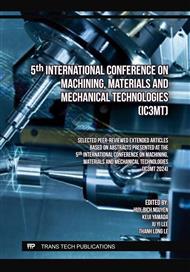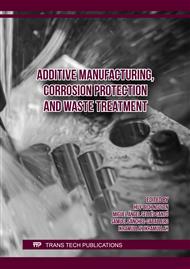[1]
I.A. Choudhury, W.C. Chong, G. Vahid, Hole qualities in laser trepanning of polymeric materials, Optics and lasers in engineering. 50.9 (2012) 1297-1305.
DOI: 10.1016/j.optlaseng.2012.02.017
Google Scholar
[2]
P. Kalvettukaran, S. Paul, K, Mondal, D. Misra, Experimental Investigation of AISI 304 Plates Deformation Through Laser Trepanning Process, Lasers in Manufacturing and Materials Processing. 10.4 (2023) 586-605.
DOI: 10.1007/s40516-023-00223-8
Google Scholar
[3]
A. Belhadj, P. Baudouin, F. Breaban, A. Deffontaine, M. Dewulf, Y. Houbaert, Effect of laser cutting on microstructure and on magnetic properties of grain non-oriented electrical steels. J Magn. Mag. Mater. 256 (2003) 20-31.
DOI: 10.1016/s0304-8853(01)00937-4
Google Scholar
[4]
G. Loisos, A.J. Moses, Effect of mechanical and Nd:YAG laser cutting on magnetic flux distribution near the cut edge of non-oriented steels, J. Mater. Process. Technol. 161(2005)151-155.
DOI: 10.1016/j.jmatprotec.2004.07.061
Google Scholar
[5]
M. Hofmann, H. Naumoski, U. Herr, H.G. Herzog, Magnetic properties of electrical steel sheets in respect of cutting: Micromagnetic analysis and macromagnetic modeling. IEEE Trans. Magn. 52.2 (2016) 1-14.
DOI: 10.1109/tmag.2015.2484280
Google Scholar
[6]
H. Naumoski, B. Riedmüller, A. Minkow, U. Herr, Investigation of the influence of different cutting procedures on the global and local magnetic properties of non-oriented electrical steel. J Magn. Mag. Mater. 392 (2015)126-133.
DOI: 10.1016/j.jmmm.2015.05.031
Google Scholar
[7]
H.T. Nguyen, C.K. Lin, P.C. Tung, V.C. Nguyen, J.R. Ho, Artificial intelligence-based modeling and optimization of heat-affected zone and magnetic property in pulsed laser cutting of thin nonoriented silicon steel, Int. J. Adv. Manuf. Technol. 113 (2021) 3225-3240.
DOI: 10.1007/s00170-021-06847-4
Google Scholar
[8]
D. Teixidor, J. Ciurana, C.A. Rodriguez, Dross formation and process parameters analysis of fibre laser cutting of stainless steel thin sheets, Int. J. Adv. Manuf. Technol. 71(2014) 1611-1621.
DOI: 10.1007/s00170-013-5599-0
Google Scholar
[9]
M.N Rohman, J.R. Ho, P.C. Tung, C.T. Lin, C.K. Lin, Prediction and optimization of dross formation in laser cutting of electrical steel sheet in different environments, Journal of Materials Research and Technology. 18 (2022) 1977-1990.
DOI: 10.1016/j.jmrt.2022.03.106
Google Scholar
[10]
H.T. Nguyen, C.K. Lin, P.C. Tung, V.C. Nguyen, J.R. Ho, Manufacturing motor core lamination from thin non-oriented silicon steel sheet direct by pulsed laser cutting using multi-quality optimized process parameters, Int. J. Adv. Manuf. Technol. (2024) 1-22.
DOI: 10.1007/s00170-024-13661-1
Google Scholar
[11]
K. Maniya, M.G. Bhatt, A selection of material using a novel type decision-making method: Preference selection index method, Mater Des. 31(2010)1785-1789.
DOI: 10.1016/j.matdes.2009.11.020
Google Scholar
[12]
M. Miloš, J. Antucheviciene, M. Radovanović, D. Petković, Determination of laser cutting process conditions using the preference selection index method, Opt. Laser. Technol. 89(2017) 214-220.
DOI: 10.1016/j.optlastec.2016.10.005
Google Scholar
[13]
T. Singh, S. Tejyan, A. Patnaik, R. Chauhan, G. Fekete, Optimal design of needle punched nonwoven fiber reinforced epoxy composites using improved preference selection index approach, J. Mater. Res. Technol-JMRT. 9(4) (2020) 7583-7591.
DOI: 10.1016/j.jmrt.2020.04.101
Google Scholar
[14]
G. Thawari, J.K.S. Sundar, G. Sundararajan, S.V. Joshi, Influence of process parameters during pulsed Nd:YAG laser cutting of nickel-base superalloys, J. Mater. Process. Tech. 170 (2005) 229-239.
DOI: 10.1016/j.jmatprotec.2005.05.021
Google Scholar



